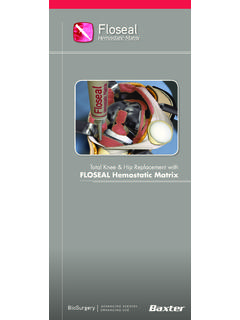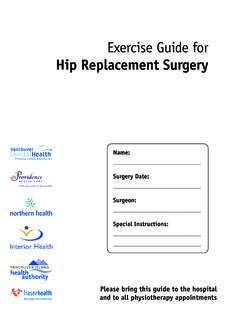Transcription of Hip replacement: New approach to an old procedure
1 hip replacement : New approach to an old procedure By Lois M. CollinsDeseret Morning News Just hours after Dr. Dick Wallin had his right hip replaced, he stood up. The next day, he used a walker to "cruise around the nurses' station" at St. Mark's Hospital, and shortly after that he learned to use crutches on a stair exercise he went home on day three, he needed only one crutch, which he discarded a week later. Within a couple of weeks, he was walking down his long driveway to retrieve the newspaper and the mail. He was also driving again."I was all set up for living in a restricted fashion, but by the time I went home in three days, I could go upstairs to my bedroom. It has been a surprisingly good experience," said Wallin of a new approach to hip- replacement surgery that's said to spare muscle and ligaments, seems to reduce the risk of dislocation, produces less pain and shortens recovery key to a "direct anterior approach " total hip replacement is the positioning of the patient during surgery and the location of the incision itself, according to Dr.
2 E. Marc Mariani, a board certified orthopedic surgeon at St. Mark's Hospital who with colleague Dr. Michael H. Bourne and Dr. Peter Novak of the Salt Lake Orthopaedic Center are the first three Utah surgeons using the technique something they predict will soon to the American Academy of Orthopaedic Surgeons, approximately 375,000 Americans undergo hip replacement surgery in hospitals around the country every year. They estimate the number will increase to 572,000 by most hip replacement surgeries, the patient lies on his side, supported by bolsters, and the surgeon cuts along the side of the hip or along the posterior. Those approaches are tried and true, says Mariani, but like all approaches, there are pros and cons. For instance, when the incision is made posteriorly, more care must be taken to avoid dislocating the new hip afterward.
3 And while most surgeons favor making the incision on the side, muscles and ligaments are cut, so recovery takes Dick Wallin recently underwent a new hip replacement procedure . He is now back hiking in the hills he By Curt WallinWith the direct anterior approach , the patient lies on her back on a specially designed operating table and a smaller incision is made in the front of the hip, near the groin. Muscles and ligaments are moved out of the way instead of detached and the hip is manipulated under fluoroscope X-ray to make sure the positioning is right. Bourne said it also allows more precise adjustment of leg length and that lying supine is safer from an anesthesia point of view because it provides a better when muscle is traumatized, bone forms in it. Not detaching the muscle greatly reduces that direct anterior approach , created by California surgeon Dr.
4 Joel M. Matta, is not yet widely available. Only as many as 6 percent of orthopedic surgeons nationwide use the new technique, in part because it has a fairly steep learning curve. "That learning curve is its downside. It's painful," said Mariani, who added that it took Matta almost 10 years to perfect the technique before he could start teaching others. "There was a lot to sort out.""Some procedures are a variation on another," said Bourne. "Not this. It's significantly different," although the components are the same. The angle, the retraction, the X-ray guidance all represent radical first investigated it, then he and Bourne set about learning to do it. They had to watch the procedure a number of times, then they practiced on cadavers Deseret Morning News Graphicuntil they were comfortable they could do it in a real patient, working as a team.
5 For the first surgeries they did using this approach they carefully selected patients based on anatomy so they had "lots of room" to work. "Now we do all of them."Combined, they have decades' experience in hip replacement . The result for the patient, they said, "is not better. It's spectacularly better. Some people are going home on the second day, with little or no restriction. When they return for a two-week checkup, most of the patients don't even need a cane."Because of the incision location, dislocation is much less of a problem, which eases many of the restrictions placed on patients in terms of initial movement. And they can be up and about much quicker. They've now used the anterior surgery in about 70 patients, implanting a Corail Total Hip System that was made for this approach to hip replacement by DePuy 's used solely for primary hip replacement .
6 "I can't imagine doing a revision this way," Mariani said. And it's not a good approach for people with certain anatomical anomalies, Mulkey has tried hip replacement both ways, with the same surgeon. Mariani replaced her first hip in 2002, and she knew she'd eventually need the other one replaced because of osteoarthritis. When the pain got bad enough to start talking about it, "I didn't want to do it. I knew it was two months of your life, gone. I kept postponing it. And Dr. Mariani was learning a new procedure and told me to hang on a bit."He was up to speed on the new surgery about the time she couldn't wait any longer, "so I bit the bullet and did it. It was a completely different operation. I was real anxious because I know what I felt like the first time I got out of bed."She found, the second time around, "big differences.
7 " She went home on a Saturday, using crutches. By Wednesday, she'd dumped them. She had fewer restrictions on simple movements, like how to get out of a chair or even sit in one. And the pain level was less. "I'm certain I didn't take a pain pill after the first week. I was 100 percent a long time ago."An avid golfer, she's out on the course doing whatever she likes, where before surgery she couldn't turn or walk well. She's always enjoyed daily workouts on the treadmill but had given that up. She went back to it, slowly, after the first week, she 's an educational consultant, training teachers in and out of Utah on how to teach kids social skills, behavior management and other things. Travel was a big part of her job, and it had become very painful. She's now back to it, without November, Mulkey, now 59, was diagnosed with rheumatoid arthritis, and the ability to exercise more fully and every day is important to managing that disease, she said.
8 "Physically, I'm doing everything I used to do."It's been 10 weeks now since Wallin, 65, had his hip replaced. And the retired emergency room doctor returned several weeks ago to the foothills he loves to hike. He expects he'll be riding his bicycle soon, as well, which he'll follow with a winter packed with ski , happy as they are with the results they're seeing, Mariani said the three doctors are taking a somewhat cautious approach . It's too new to have had much long-term information available. They're doing their own studies, tracking patients to see how they do.







